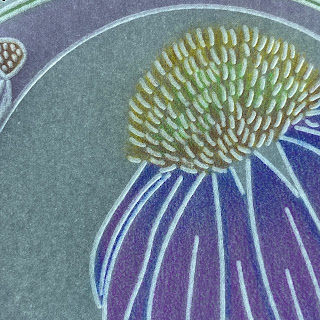Hiya. It’s me again.
It was so lovely to create the new Groovi artwork a couple of days ago. With the best of intention, I was going to create another card yesterday so we can #sayitwithflowers together but baking a cake won the toss!
So instead, today I will share with you the steps to a card I had prepared for a workshop last year but life got in the way and I had to cancel. I love colour and more often than not I colour on the back of my work because I love the crisp white lines we get with the Groovi plates. But this workshop was going to be about colouring on the front for more vibrancy as when we colour on the back and the nature of the transluscent parchment makes the colours appear softer on the front. For today’s step by step, I have embossed the outlines but you can use this technique without embossing the outlines by placing the parchment to the smooth side of the Groovi plate. Here are 2 samples using the same flower from Linda’s 123 plate to show you the difference …
Groovi Plates:
Alphabet A5 Square Groovi Plate Mate GRO-MA-40002-07
Nested Scallops Circles A5 Square Groovi Plate GRO-PA-40558-03
Linda’s 123 - D Bumble bee, Clover & Coneflower A4 Square Groovi Plate GRO-FL-40989-15
NOTE:
The outline embossing of the main element is done on the front and the rest on the back.
The colouring of the main element is done on the front and the rest on the back.
All the perforating and cutting are done from the front.
Step 1: Emboss the 3rd largest double circle outlines (not the scallops) from the Nested Scallops Circles plate using the Pergamano 1mm ball tool (or Groovi No.1).
Step 2: On the front of the parchment, using the Pergamano 1mm ball tool (or Groovi No.1), deboss the circle and the largest floral design from Linda’s 123 plate.
(Embossing from the front is called debossing)
Step 3: Remove the parchment, turn it to the back and emboss the little flowers in the space between the circles using the Pergamano 1.5mm ball tool (or Groovi No.2) for the flower petals and the Pergamano 1mm ball tool (or Groovi No.1) for the leaves, stems and flower heads.
Step 4: Emboss the small flower petals on the back using the Pergamano 3mm and 1.5mm ball tools (or Groovi No.2 and No.3).
Step 5: On the back, colour the little flower heads, leaves and between the outside double circle outlines using the Perga Colours Exclusives.
(I have used PCE1, PCE16 and PCE21)
Step 6: Colour in the space between the circles with Perga Liner B pencil and blend using a
Dorso oil and blending nibs.
(I have used B5 and B14)
Step 7: Colour on the front:
Make sure the pencils are sharp.
Using very light feathering strokes, flick colour using the darkest colour from the centre to the outside as well as from the outside to the inside of each petal.
Flick some longer, some shorter strokes, about a 1/3 of the way, following the shape of each petal
(I have used B4).
Step 8: Using very light feathering strokes, starting at the top and going over the previous colour, flick colour, using the second medium colour, from the centre to the outside as well as from the outside to the inside of each petal. These will be longer flicks so the whole middle part of the flower gets filled (I have used B14).
N.B. If you are using a larger flower, you may need to use a third, lighter colour and repeat.
Step 9: Repeat flicking pencil lines for the flower head using a yellow, green and brown.
(I have used B3, B7 and B8).
Step 10: Still working on the front, shallow perforate using the 5-needle perforating tool outside the main circle, making sure the first 2 needles of the tool goes into the last holes of the previous perforation.
Step 11: On the back, using the 1.5mm ball tool (or Groovi no.2) emboss a circle around the alternate middle hole of the 5-needle perforations
(Don’t worry about the perforations getting squashed as we will be re-perforating all the holes again)
Step 12: From the front, using the 5-needle perforating tool, line up the needles to the holes of the alternate embossed perforations, re-perforate and while the needles are still in the parchment, twist the tool very slightly to the left and then to the right to elongate the holes (Do not twist the tool too much otherwise the middle will fall out).
Using the fine 1-needle perforating tool, re-perforate all the centre holes over the super foam.
Step 13: From the front, with the scissors over the waste, picot cut between all the outside perforations.
To Finish:
Depending on how many layers of backing card and size of card you want, cut each layer slightly larger than the previous one. (I have used 11x11cm purple parchment, 11.5x11.5cm white card and 12x12cm Antarctica designer card).
Attach the parchment piece to the first smallest backing card (if you have used more than one) using brads. Stick this onto the other layers using double sided sticky tape (or glue tape pen).
The layers are stuck on a folded white card measuring 5”x5”. using double sided sticky tape (or glue tape pen).
Sign your card on the back, turn it round, admire and be proud of your creation.
I hope you enjoyed this step by step journey and I look forward to seeing all your #sayitwithflowers creations using these Groovi plates (and others).
Groovi plates and ingredients are available on http://www.claritystamp.com. Look out for more of Linda’s 123 plates which are all very beautiful as is all her work.
Sending everyone STAY SAFE WISHES sprinkled with PERGA GLITTER. Take care.
Lots of Love, Hugs and Laughter
Tina x
P.S. The cake I baked was Lemon Coconut!

















